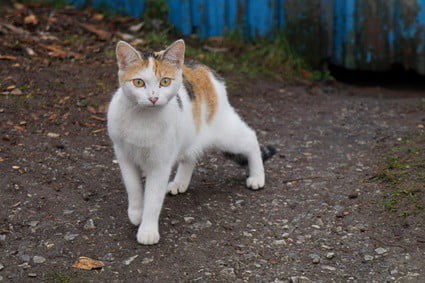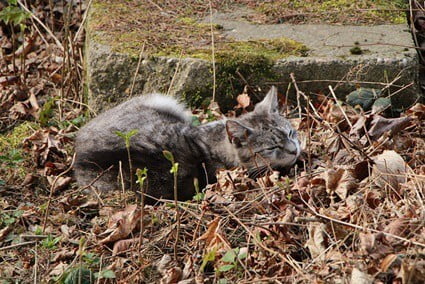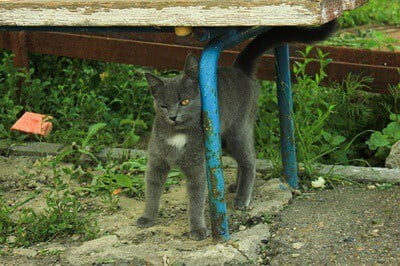Cats pooing and urinating in your yard can introduce a range of health concerns connected to germs, bacteria, and parasites. Cats can also ruin your lawn, destroying property and uprooting plants. Whether it’s your own cat or a stray that’s making a mess, cat poop and pee can be a pain.
You can prevent stray and neighborhood felines from soiling your yard with unpleasant smells, physical barriers, water, and noise-based deterrents. When it comes to your own house cats, you can take steps to reduce their territorial instincts and set up an outdoor litterbox.
Beyond these methods, there are also some things you can do to address the root cause of the problem. Supporting shelters and trap-neuter-release programs can help to reduce the stray population of cats in your area.
Prevent Cats Using Yard As a Toilet
There are 4 ways to stop cats from pooping and peeing in your front or back yard: odor repellents, physical barriers, water, and noise deterrents.
Odor Repellents
A cat’s sense of smell is much more sensitive than that of humans. In fact, they have 200 million odor receptors compared to our 5 million odor receptors. Deterring cats using their sense of smell can be a quick and easy way to remove cats from your lawn.
Commercial Repellents
There are a few cat deterrents on the market that use a cat’s sensitive sense of smell. Some cat repellents use the scents of a cat’s natural predators, like foxes and coyotes, to deter cats.
Some spray formulations use plant smells for a more natural approach. Some brands are even motion-activated, so that the formula is only used whenever a cat is nearby.
Homemade Spray
If you don’t want to buy a cat deterrent, you can also make your own. This DIY recipe uses a few kitchen staples. What’s more, it smells nice to humans and terrible to cats. To make this homemade spray, you will need:
- 1 teaspoon cayenne or black pepper
- 1 teaspoon cinnamon
- 1 teaspoon dried mustard
- 1 garlic clove, crushed
- 3 drops lemon essential oil
- 2 oz. water
Simply add the ingredients in a spray bottle and shake to combine.

DIY Repellents
If you don’t want to shell out money for a cat deterrent or make your own, you can use materials you may have lying around.
Alternatives include vinegar, blood meal fertilizer, and coffee grounds. Just spread these materials around the garden to drive cats away.
Plants
Other than actively adding smells into your lawn or yard, why not plant it? There are plants with smells that cats dislike. These include the following.
- Rue
- Lavender
- Pennyroyal
- Citrus (lemon, lemon thyme, lime, grapefruit)
- Geranium
- Marigold
- Scaredy cat plant (Coleus canina)
For the best results, plant these around the perimeter of your lawn or yard.
Essential Oils
Essential oils are a good alternative to plants. They’re easy to buy, and they smell nice as well. Any smell that has been previously listed will work great as an essential oil.
Just make sure to dilute the oils you are using. Also, be mindful of any pets and toddlers that are around. Essential oils can be dangerous to both humans and animals in concentrated form.
Physical Barriers
Physical barriers may be the cheapest, less labor intensive, and most reliable way to deter cats. Here are some ways to deter cats using physical barriers.
Board Up Hiding Spaces
One of the reasons why cats visit lawns is to find a place to stay and to breed. You can discourage cats from staying and have litters in your backyard by boarding up these spaces.
Make sure to keep garage and shelter doors closed. Board up any holes under decks and porches. Remove objects that can be crawled in, like piles of wood.
Rough Materials As Ground Cover
Cats lawns because they like to dig. Cats also prefer to poop and urinate on loose soil. The trick to deterring cats is to add rough materials to the soil. Raising flower beds by adding mulch can easily deter a cat.
You can get creative with the mulch you use. As long as it won’t hurt your plants, it’s good to go. Materials like pinecones, eggshells, and stone mulch are good choices.
For really stubborn cats, you can cover the ground with chicken wire. While this isn’t the most practical choice for all yards, it will likely stop cats from digging.
Fences
Fences are another way to set up a physical barrier against stray cats. Fences can be effective when used alongside other methods.
There are differing opinions about whether or not electric fences are humane. No matter which camp you belong to, there are still a lot of things that can stop you from buying an electric fence.
There is the hefty price, as well as the time and effort it would take to install. Electric fences may also go against local laws.
Instead of using electric fences, you could modify your existing fence to deter cats. There are ways you can achieve this, including:
- Attach cut out plastic bottles curved side up on the top edge of your fence. This will remove pipes or the ability of cats to balance on this edge. The flimsier the bottle, the better it will be as a deterrent.
- Place string or wire 10 to 15 cm above the top edge of the fence. This will also remove the ability of cats to balance on a fence’s top edge.
- If you are using a chicken wire fence, bend it to the direction cats approach from. Cats are unable to climb this fence because of its arc.
Water-Based Deterrents
Water is a classic way to prevent cats. You can manually spray cats yourself or use a sprinkler system.
Water Guns
Spraying water on cats is a common way to deter them. Using a hose or water gun can be an effective way to drive away feral cats.
Sprinkler System
For less manual methods, use water sprinklers. If you don’t mind the cost, consider infrared water sprinklers. These sprinklers use infrared to detect movement and will turn on automatically.
Noise
Aside from their sense of smell, cats also have a sensitive sense of hearing. There are many brands of ultrasonic cat deterrents on the market. But the question is, do they work?
Ultrasonic Cat Deterrent
A cat deterrent device uses ultrasonic sound to deter animals. It means that it makes sounds at a high frequency. These frequencies can only be heard by cats, and not humans. The theory is that this high-pitched noise is unpleasant to cats.
There isn’t a lot of evidence that points to cat deterrents being particularly effective. In a study published in Global Ecology and Conservation, cat deterrents reduced the number of intrusions and lessened the time cats spent in an area.
However, scientists noted that this wasn’t true for cats that were more likely to roam. Likewise, in a study published in the British Veterinary Association, cats spent more time, instead of less time, in an area with a cat deterrent.
On the other hand, it is still a method that is worth trying, if you are so inclined.
| Method | Description | Effectivity |
|---|---|---|
| Commercial Repellents | Commercially available odor-based repellent | Mostly effective, depending on formulation |
| Homemade Spray | A homemade version of an odor-based repellent mix | Less effective than commercial repellent |
| DIY Repellents | Other kitchen staples as an odor-repellent | Less effective than commercial repellent |
| Plants | Some plants have odors that cats do not like | Depends on the plant used |
| Essential Oils | Essential oils of smells that cats do not like | Effectivity depends on the scent used. |
| Board Up Hiding Spaces | Close up any hiding spaces wherein cats can sleep and breed | Very effective |
| Rough Materials As Ground Cover | Add mulch to stop cats from digging | Very effective |
| Fences | Alter fences to be effective against cats | Very effective |
| Water Guns | Water is a classic deterrent against cats | Will depend on individual cats |
| Sprinkler System | Automate water deterrents | Will depend on individual cats. |
| Ultrasonic Cat Deterrent | A device that emits a high-pitched sound unpleasant to cats | Not effective |
Stopping Cats from Pooping In Yard
Most of the time, strays are responsible for poop and urine in a yard. But if it’s your cat that’s doing the soiling, you have a few more options.
A domesticated cat that likes to poop outside may do so for a few reasons. The solution to stop your cat from soiling your lawn is figuring out why they do so in the first place. Here are two methods you can do to address your cat’s bathroom habits.
Lessen Territorial Instinct
Cats are territorial, and they use the scent of their waste as territory markers. They may make markings when they feel like their territory is under threat. This often happens in areas where there are a lot of cats nearby.
To solve this problem, move your cat to an area where there are fewer cats. Or remove your cat’s ability to see other cats. You can do this by not allowing your cat to roam outdoors.
Provide A Better Toilet
On the other hand, your cat may simply like the outdoors better than its indoor litter box.
The solution to this is to make a litter box outdoors. Fill this with sand, which cats will prefer over other substances. In this way, you can contain the waste in one area, making it much easier to clean.
Reduce The Chances of Cat Waste
There are many things you can add to your yard to deter it from cats. But there are also some things you can do to not make your yard enticing to cats in the first place.
Remove Sources of Food
The smell of food will attract cats into your yard, as well as other animals. Make sure to remove all sources of food as soon as possible. These include grills, outdoor tables, and trash cans.
If you cook or eat outside, make sure to clean up any bits of food from grills and surfaces.
For trash cans, secure them with a tight lid. If tight lids aren’t an option, wrap a bungee cord around trash cans. Other than protecting your trash cans from cats, this will protect your yard from other animals as well.
Wash Out Urine
Other than smells of food, another thing to keep an eye out for is urine smells. Urine is a way for cats to mark their territory.
Wash out urine from surfaces as soon as you notice them. Use an enzyme-based odor neutralizer to fully remove the smell.
Clean Up Clutter
Cats like to stay in a place with a lot of hiding spaces. These spaces, like brushes and clutter, can house small animals like mice and raccoons. Keeping these spaces clear will make your lawn less enticing to cats.
Remove Bird Feeders And Birdhouses
The presence of birds will attract cats into your yard. On top of that, bird feeders can also attract small critters like mice, which cats like.
Try to move your bird feeder to a place that only birds can reach. You can also try to change the design of your bird feeder to make it safe from cats. To lessen the presence of mice, invest in a feeder designed to deter pests. Alternatively, bring the feeder inside at night.
Birdhouses too may pose the same problems. Invest in a design that deters cats and keeps birds safe.
When all else fails, remove bird feeders and birdhouses entirely. In any case, avoid ground feeding at all costs.

Add A Cat-Friendly Area
No matter how hard you try to deter cats from your yard, the reality is that they will always be there. Instead of doing all you can to remove them from your property, why not strike out a compromise? Consider giving community cats a small space made specifically for them.
Much like providing a house cat with an outdoor litter box, a cat-friendly area will contain waste in one area. This method may be more effective at stopping your cat from pooping and urinating on your lawn. With their own space, cats will more likely leave the rest of your yard alone.
How do you make a cat friendly area? All you need is to make a sandbox. If possible, add some catnip nearby. This box will work as a litter box, keeping the rest of your yard safe.
If you want to go the extra mile, you can also provide feral cats their own food. Chances are, this will also lessen the chances of parasites and bacteria that feral cats ingest.
Make sure to keep feeding spots in one area, clean up food after thirty minutes, and keep it clean and secure from other animals.
Deterring Cats And Their Waste Tips
Keeping cats out of your backyard isn’t just adding deterrents and removing items that cats like. There are some things you can do that address the issue.
Talk To Your Neighbors
One of the best ways to address a feral cat problem is by talking to your neighbors. After all, a cat’s territory often extends past your own yard.
In fact, Wildlife Research found that feral cats can have a home range of up to 17 hectares. If you’re having trouble with a feral cat, chances are your neighbors are, too.
Talk to your neighbors if they’re having the same problem. Check to see if their yards encourage cats to stay. Ask if your neighbors feed feral cats. Feeding feral cats can lessen problems, but only if done correctly. Make sure that food is contained in one area, cleaned up after thirty minutes, and that the feeding area is kept clean and secure.
The cat visiting your yard can even be a neighbor’s pet. If this is the case, discuss any options to keep their cats indoors. Or, at the very least, keep them contained in your neighbor’s property.
Support Community Programs
There are community programs, like trap-neuter-release programs and feral sanctuaries, which address the problem of feral cats. If you have a big population of strays in your area chances are, there are programs you can support.
Trap-neuter-release programs are an alternative to shelters. Shelters often choose to euthanize cats, both because of a lack of resources, and to curb stray cat populations. However, euthanasia is considered an ineffective way to curb stray populations. Euthanasia creates a rebound effect, in which the population of strays simply rebounds back to its original numbers.
Instead, TNR programs neuter cats and releases them back into the wild. According to The Veterinary Journal, areas with TNR programs show a 66% decrease in cats being impounded. This is compared to a 12% decrease in cats wherein there is no TNR program.
Support Shelters And Facilities
Shelters and facilities do have their own role in curbing the stray population. Shelters can house cats and keep them off the street.
In some cases, there are cats that can still be socialized and put in their own loving home. However, shelters lack enough resources to care for and house cats. The more support shelters and facilities have, the more they can do for stray cats.
What can you do to support shelters and facilities? One way is to volunteer your time. Donating in both cash and goods is also a good idea.
Cat Deterrent Methods To Avoid
Feral cats are a problem in any neighborhood. They bring a lot of issues, including diseases and parasites. However, there are some things that should never be used on cats. These include the following:
- Poison, or toxins
- Shooting, even with non-lethal options like pellet guns
- Inhumane traps like glue traps
- Aggressive animals like dogs
Not only are these approaches ineffective in the short term, but they can be more harmful than stray cats themselves.
These alternative methods are hard to control, and also unpredictable. They can harm not only cats, but other animals and people in the area as well. On top of that, they may violate local laws.

